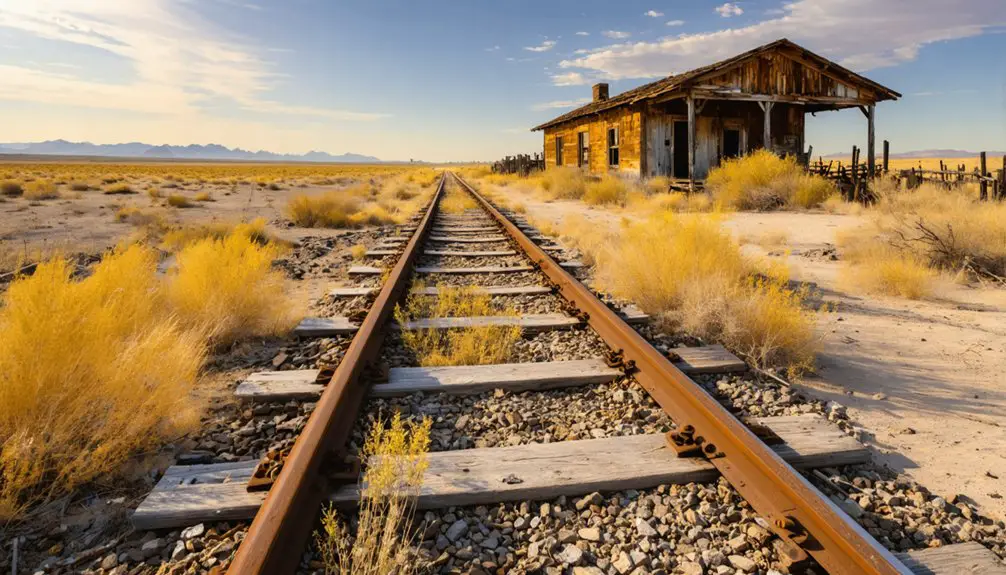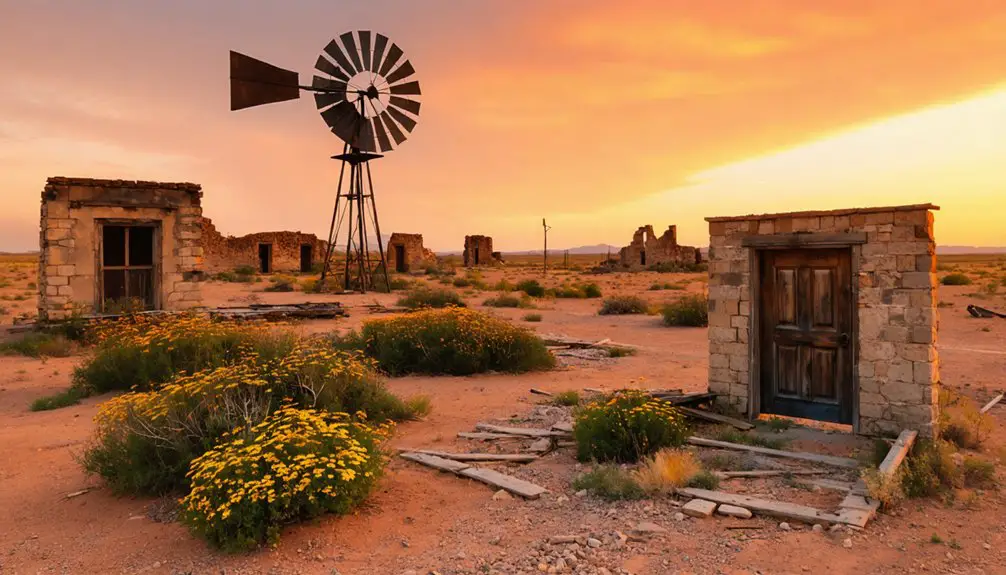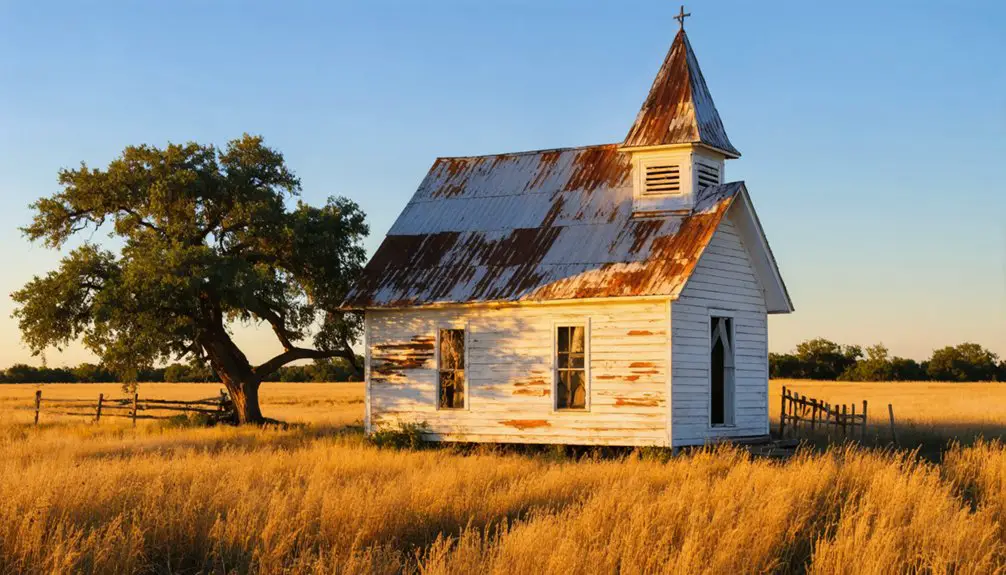You’ll find Acala, Texas nestled along the former Southern Pacific Railroad tracks in West Texas. This ghost town emerged in the early 1900s as a thriving cotton community, peaking at 100 residents in the late 1950s. W.T. Young’s cotton gin and the town’s strategic location along both rail and highway routes fueled its success. After Interstate 10’s construction in 1957 diverted traffic, Acala’s population dwindled to just 11 residents by 2020. The remnants tell a deeper story of agricultural innovation and railroad commerce.
Key Takeaways
- Acala, Texas is a ghost town that once thrived as a cotton farming community near the Southern Pacific Railroad tracks.
- The town peaked at 100 residents in the late 1950s before declining to just 11 residents by the 2020 census.
- Construction of Interstate 10 in 1957 and removal of the railroad spur line led to Acala’s economic decline.
- The settlement was established before 1925 and became prosperous through cotton production and strategic railway transportation.
- Despite ghost town status, active cotton fields and irrigation canals remain as testament to Acala’s agricultural heritage.
The Birth of a Cotton Town
While the name Acala would eventually become synonymous with premium cotton across the American Southwest, its origins trace back to a small patch of cotton near Acala, Chiapas, Mexico. At 3,000 feet elevation, this Mexican cotton variety caught the attention of the U.S. Department of Agriculture in 1906, who brought it to San Antonio for testing. By 1927, 400,000 acres of Acala cotton were being cultivated across the Southwest. You’ll find that cotton cultivation rapidly transformed after D.A. Saunders began making selective breeding improvements in 1909. His work enhanced the cotton’s fiber characteristics, developing what would become known as Acala-8. The cotton industry evolved dramatically with the introduction of automated ginning systems by Robert S. Munger in 1884.
Early Settlement and Pioneers
Although desert conditions posed significant challenges, pioneering settlers established Acala before 1925 near the Southern Pacific Railroad tracks in Hudspeth County, Texas.
You’ll find that these determined pioneers, led by W.T. Young of El Paso, transformed harsh scrubland into productive cotton fields through sheer determination and community resilience.
The pioneers overcame numerous challenges to build their desert community:
Against harsh desert odds, these resilient pioneers conquered every obstacle to forge a thriving community from unforgiving land.
- They cleared dense scrub-brush using mule teams.
- They engineered complex irrigation systems from the Rio Grande.
- They constructed essential infrastructure including roads and a cotton gin.
- They introduced the Acala cotton variety, proving it could thrive in the region.
The community’s spirit attracted more settlers, growing from 50 residents in 1927 to 100 by 1929, though they’d face more challenges in the decades ahead. The establishment of a post office before 1925 under postmistress Julia A. Vaughn marked an important milestone for the growing settlement. The completion of Bankhead Highway in 1926 brought new opportunities and economic growth to the developing town.
Agricultural Innovation in the Desert
The determined spirit that drove Acala’s early settlers soon sparked remarkable agricultural innovations in the harsh desert environment.
You’ll find that their pioneering irrigation techniques transformed barren desert into productive farmland by tapping into the Rio Grande’s life-giving waters. They’ve carved out an extensive network of canals and wells, initially dug by mule power, to sustain their ambitious farming ventures. Much like the native desert succulents, local farmers relied heavily on drought-resistant plants to supplement their cultivated crops. Located thirty-four miles northwest of Sierra Blanca, the town’s strategic position along the Rio Grande made irrigation possible.
You can trace their agricultural success to the introduction of acala cotton, a hardy Mexican variety perfectly suited to the region’s conditions.
They didn’t stop there – they’ve developed crop resilience through smart diversification, growing everything from corn to cantaloupe.
While they started with manual labor and animal power, they’ve adapted to changing times, gradually embracing mechanization to boost their farming efficiency in this challenging desert setting.
Life Along the Railroad
Life along Southern Pacific’s railway defined Acala’s golden era, as the steel rails became the town’s economic lifeline. The railroad culture shaped every aspect of daily existence, from the strategic placement of cotton gins near the tracks to the scheduling of harvests around train departures. Like many Texas towns in the early 1900s, Acala benefited from the state having the most mileage of railroad track by 1911.
You’ll find that community connections flourished around the depot, where four key elements defined the railway experience:
- The rhythmic arrival of freight trains dictating the town’s daily pulse
- Farmers gathering at sidings to coordinate cotton shipments
- Local businesses thriving along the Bankhead Highway-rail corridor
- The depot serving as a crucial social hub for news and gatherings
But when Southern Pacific removed the spur track, Acala’s vibrancy faded, marking the beginning of its decline toward ghost town status. Today, railroad enthusiasts can explore similar transportation history at 11731 Wetmore Road in San Antonio.
The Cotton Boom Years
During Acala’s peak cotton production era, you’d have witnessed a remarkable intersection of agricultural innovation and railroad commerce that transformed this small Texas community into a significant shipping point.
You’d have seen early mechanized farm equipment working alongside traditional labor methods as farmers maximized their yields of the high-quality Acala cotton variety, which commanded premium prices for its superior fiber length and strength.
The town’s strategic position along the railroad enabled farmers to efficiently transport their cotton to major markets, while the introduction of specialized prairie plows and other technological advances helped expand cultivation across previously untapped acreage. By the 1830s, Texas had become a major cotton producer, generating 3.15 million pounds annually.
Peak Production Era Highlights
When agricultural pioneers first experimented with Acala cotton near Tornillo in 1917, they couldn’t have predicted the dramatic transformation that would sweep through Texas’s southern valleys.
Through innovative irrigation techniques and careful selection of cotton varieties, these bold farmers turned barren desert into flourishing fields. Similar to Spanish mission lands, California’s early cotton cultivation began centuries before achieving commercial success.
The peak production era around 1920 marked several remarkable achievements:
- W.T. Young’s ambitious land purchase near the Southern Pacific Railroad, clearing desert with mule power
- Construction of the region’s first cotton gin, revolutionizing local processing capabilities
- Introduction of U.S. Highway 80, dramatically improving transportation access
- Development of superior Acala cotton strains, reaching staple lengths up to 1 3/16 inches and strength of 95,000 PSI
These developments forever changed the landscape of Texas cotton farming.
Railroad Shipping Advantages
The strategic placement of Southern Pacific Railroad tracks near Acala transformed the region’s cotton industry into a powerhouse of efficiency.
You’ll find that railroad advantages extended beyond mere transportation – the rail siding served as an essential shipping point that connected local cotton producers to national markets.
When combined with the newly constructed Bankhead Highway, you’d have seen unprecedented shipping efficiency through this dual transport network.
The railroad’s presence attracted significant development, including W.T. Young’s cotton gin built strategically near the tracks.
You could’ve witnessed how this infrastructure sparked rapid growth, as the rail-irrigation synergy created perfect conditions for cotton production.
The Southern Pacific’s integration with larger rail corridors meant you’d have access to extensive trade networks, cementing Acala’s position as a thriving cotton hub.
Farm Technology Advances
Following its introduction to West Texas in 1917, Acala cotton revolutionized farming practices through innovative breeding programs and irrigation advances.
You’d find pioneers transforming desert scrubland into productive fields using irrigation techniques from the Rio Grande. While mechanization advancements were still limited, mules played a vital role in land clearing and soil preparation.
The agricultural revolution brought four major changes to cotton farming:
- Development of superior Acala strains through university breeding programs
- Implementation of strategic water management via irrigation canals
- Scientific fertilizer application to boost per-acre yields
- Advanced seed selection targeting staple length and fiber strength
These improvements helped Acala cotton outperform other varieties in 80% of trials, making it the preferred choice for farmers seeking independence and higher profits in Texas’s arid regions.
Transportation and Trade Routes

Located at the intersection of essential transportation arteries, Acala’s development was shaped by its strategic position along both the Southern Pacific Railroad and the Bankhead Highway (later U.S. Highway 80).
You’ll find that these crucial routes connected local farmers directly to larger markets, particularly El Paso, revolutionizing the region’s trade dynamics.
The transportation evolution began with mule-drawn clearing, but the railroad’s arrival transformed Acala into a significant cotton shipping point.
The rail siding allowed farmers to load their cotton directly for transport, while the highway system provided flexible alternatives for moving goods.
The integration of extensive irrigation canals with these transport networks created ideal conditions for cotton cultivation and export, though later shifts in transportation modes and economic patterns would eventually contribute to the town’s decline.
From Prosperity to Decline
While rail lines and highways once brought prosperity to Acala, shifting economic winds would ultimately lead to its downfall. The town’s cultural heritage and community resilience were tested as several factors converged to challenge its existence.
- You’d have witnessed the population peak at 100 residents in the late 1950s before technological advances in farming reduced the need for manual labor.
- You’d have seen Interstate 10’s construction in 1957 divert traffic away from your community, weakening local commerce.
- You’d have felt the impact when Southern Pacific removed its spur line, cutting off crucial transportation links.
- You’d have watched as your neighbors departed, with the population plummeting to just 25 by the early 1970s.
The town’s dependence on cotton farming and changing transportation patterns ultimately proved insurmountable challenges to its survival.
The Legacy of Acala Today

Despite its official ghost town status, Acala maintains a tenuous grip on existence with 11 residents recorded in the 2020 census.
You’ll find functioning irrigation canals and active cotton fields that preserve the agricultural heritage that gave the town its name. The community’s cultural preservation efforts are evident through its inclusion in ghost town tourism routes and historical documentation.
While many buildings have succumbed to time, you can still explore the remaining structures and witness the legacy of cotton farming that shaped this region.
Though Interstate 10’s construction diverted traffic elsewhere, Acala’s community identity endures through its ZIP code, area code, and recognition in regional history.
Modern highways may bypass Acala, but its identity persists through official designations and historical significance.
The town’s story lives on through documentaries and media coverage, attracting visitors interested in Texas’ vanishing rural communities.
Exploring the Desert Ghost Town
As you venture into Acala’s sun-scorched landscape, you’ll find yourself 54 miles southeast of El Paso at an elevation of 3,576 feet, where abandoned buildings and rusting farm equipment tell the story of a once-thriving cotton community.
Desert wildlife now inhabits the weathered structures where cotton farmers once pursued their dreams of agricultural prosperity.
While exploring this remote ghost town, you’ll discover:
- Deteriorating ranch houses that showcase authentic early 20th-century architectural details
- Historical artifacts from the cotton industry, including remnants of the original gin
- Vintage trucks and farm equipment slowly reclaimed by the harsh desert environment
- The old grocery store, a silent indication of the community’s former significance
Follow State Highway 20 near the Southern Pacific Railroad tracks to access this forgotten piece of Texas history.
Frequently Asked Questions
What Native American Tribes Originally Inhabited the Acala Area?
While you might think Apaches were first, the Jumano people dominated the area’s tribal history, followed by Coahuiltecan bands. These groups established rich cultural heritage before Apache and Comanche arrival.
Were There Any Notable Crimes or Lawlessness in Acala’s History?
You won’t find documented crime reports or notable law enforcement incidents in this town’s history. The area’s sparse population and agricultural focus meant typical criminal activity remained minimal and unremarkable.
What Was the Average Cost of Land in Acala During Its Peak?
While a cotton farmer might’ve bought desert plots cheaply, exact land prices aren’t documented. You’d have seen economic trends favoring parcels near railroads and irrigation access during the 1920s agricultural peak.
Did Any Famous Personalities or Politicians Ever Visit Acala?
You won’t find any records of famous visitors or politicians coming to Acala. The town’s small size and agricultural focus meant it didn’t have enough political influence to attract notable personalities.
Were There Any Significant Natural Disasters That Affected Acala?
Like a fortress against nature’s fury, you won’t find records of major natural disasters striking this settlement. Instead, economic impacts from human factors like mechanization and infrastructure changes shaped its destiny.
References
- https://www.legendsofamerica.com/acala-texas/
- https://klaq.com/ghost-towns-near-el-paso/
- https://en.wikipedia.org/wiki/List_of_ghost_towns_in_Texas
- https://www.texasescapes.com/TexasGhostTowns/AcalaTexas.htm
- https://www.allacrosstexas.com/texas-ghost-town.php?city=Acala
- https://www.ghosttowns.com/states/tx/falba.html
- https://www.youtube.com/watch?v=Vru7H6lStbA
- https://www.tshaonline.org/handbook/entries/acala-tx
- https://archive.org/download/historyofacalaco16turn/historyofacalaco16turn.pdf
- https://pureecoindia.in/organic-cotton-in-usa/



